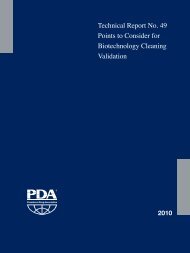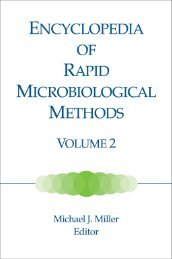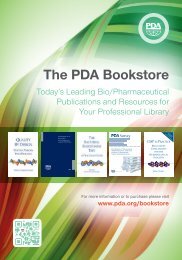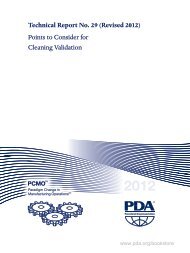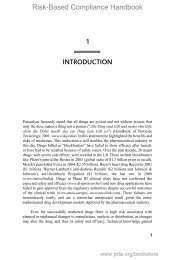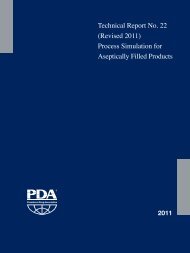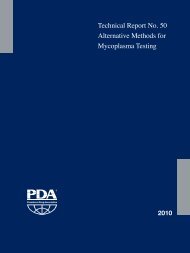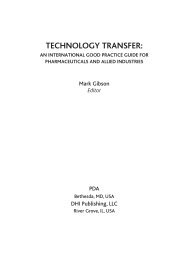Analytical Method Validation and Transfer for Biotechnology Products
Analytical Method Validation and Transfer for Biotechnology Products
Analytical Method Validation and Transfer for Biotechnology Products
Create successful ePaper yourself
Turn your PDF publications into a flip-book with our unique Google optimized e-Paper software.
Technical Report No. 57<br />
<strong>Analytical</strong> <strong>Method</strong> <strong>Validation</strong> <strong>and</strong><br />
<strong>Transfer</strong> <strong>for</strong> <strong>Biotechnology</strong> <strong>Products</strong><br />
Bethesda Towers<br />
4350 East West Highway<br />
Suite 200<br />
Bethesda, MD 20814 USA<br />
www.pda.org/bookstore
PDA <strong>Analytical</strong> <strong>Method</strong> <strong>Validation</strong> And <strong>Transfer</strong> For <strong>Biotechnology</strong> <strong>Products</strong> Task Force Members<br />
Authors<br />
Stephan O. Krause, Ph.D., Chair, MedImmune<br />
Florence Baudoux, Ph.D., GlaxoSmithKline<br />
Pierre Douette, Ph.D., Eurogentec S.A.<br />
Nicole Gibelin, Ph.D., Sanofi Pasteur, France<br />
Alice E. Grebanier, Ph.D., Centocor R&D<br />
Contributors<br />
Patricia W. Cash, Ph.D., MedImmune<br />
Larissa Chirkova, Novozymes<br />
Marta Germano, Pharming Technologies<br />
Siegfried Giess, Ph.D., Paul-Ehrlich Institute<br />
Rashmi Rawat, Ph.D., U.S. FDA<br />
Rajesh Krishnamurthy, Ph.D., Zyngenia, Inc.<br />
Carl-Gustav, Millinger, Ph.D., Swedish Orphan<br />
Biovitrum<br />
Frank Moffatt, Ph.D., Solvias AG<br />
Dwayne Neal, SAIC-Frederick, Inc.<br />
Phillip Ramsey, SAIC-Frederick, Inc.<br />
Michael Rooney, Ph.D., BioTechLogic<br />
Melissa J. Smith, MJ Quality Solutions<br />
Michael Warncke, Ph.D., Bayer HealthCare<br />
Earl K. Zablackis, Ph.D., Sanofi Pasteur, USA<br />
The content <strong>and</strong> views expressed in this Technical Report are the result of a consensus achieved by the authorizing<br />
Task Force <strong>and</strong> are not necessarily views of the organizations they represent.<br />
www.pda.org/bookstore
<strong>Analytical</strong> <strong>Method</strong><br />
<strong>Validation</strong> <strong>and</strong> <strong>Transfer</strong> <strong>for</strong><br />
<strong>Biotechnology</strong> <strong>Products</strong><br />
Technical Report No. 57<br />
ISBN: 978-0-939459-41-4<br />
© 2012 Parenteral Drug Association, Inc.<br />
All rights reserved.<br />
Bethesda Towers<br />
4350 East West Highway<br />
Suite 200<br />
Bethesda, MD 20814 USA<br />
Tel: 1 (301) 656-5900<br />
Fax: 1 (301) 986-0296<br />
E-mail: info@pda.org<br />
Web site: www.pda.org<br />
www.pda.org/bookstore
Table of Contents<br />
1.0 Introduction........................................................... 1<br />
1.1 Scope <strong>and</strong> Purpose .............................................. 1<br />
2.0 Glossary of Terms ................................................. 4<br />
2.1 List of Abbreviations ........................................... 9<br />
3.0 General Assessment of <strong>Method</strong> <strong>Validation</strong><br />
Readiness ............................................................ 10<br />
3.1 General Risk Assessment Process ..................... 13<br />
3.2 Setting AMV Protocol Acceptance Criteria ........ 16<br />
3.2.1 Rationale ....................................................... 16<br />
3.2.2 Consistent Risk Assessment to Set<br />
Acceptance Criteria ..................................... 17<br />
3.3 Example <strong>for</strong> AMV Protocol Acceptance Criteria ....... 18<br />
3.3.1 Setting <strong>and</strong> Justifying Acceptance<br />
Criteria <strong>for</strong> the AMV Protocol ...................... 19<br />
4.0 <strong>Analytical</strong> <strong>Method</strong> <strong>Validation</strong>.............................. 20<br />
4.1 AMV Characteristics ......................................... 22<br />
4.1.1 Accuracy .................................................... 22<br />
4.1.2 Repeatability Precision ................................ 22<br />
4.1.3 Intermediate Precision ................................. 23<br />
4.1.4 Reproducibility (Precision) .......................... 24<br />
4.1.5 Specificity.................................................... 24<br />
4.1.6 Linearity ....................................................... 24<br />
4.1.7 Range .......................................................... 25<br />
4.1.8 Detection Limit (DL)..................................... 25<br />
4.1.9 Quantitation Limit (QL) ................................ 26<br />
4.1.10 Typical AMV Execution Matrix .................... 26<br />
4.2 Additional AMV Characteristics<br />
to be Considered ................................................ 27<br />
4.2.1 Assay Bias <strong>and</strong> <strong>Analytical</strong><br />
Response Factors ........................................ 29<br />
4.2.2 Stability of Samples, St<strong>and</strong>ards, Controls,<br />
Reagents, <strong>and</strong> Material ............................... 29<br />
4.2.3 System Suitability ....................................... 30<br />
4.2.4 Sample Suitability ....................................... 30<br />
4.2.5 Statistical Data Reduction ........................... 31<br />
4.2.6 Robustness .................................................. 31<br />
4.2.7 Degradation ................................................. 31<br />
4.2.8 Significant Digits in Reported Results ........... 32<br />
4.2.9 Validating Other <strong>Analytical</strong> Technologies ..... 33<br />
4.3 <strong>Analytical</strong> <strong>Method</strong> Verification ........................... 33<br />
4.3.1 Verification Process ...................................... 33<br />
4.3.2 Verification Requirements ............................. 34<br />
4.3.3 Retrospective Data ....................................... 34<br />
4.4 AMV Documentation .......................................... 34<br />
4.4.1 AMV Protocol .............................................. 34<br />
4.4.2 AMV Report ................................................. 35<br />
5.0 <strong>Analytical</strong> <strong>Method</strong> <strong>Transfer</strong> .................................36<br />
5.1 Prerequisites to AMT........................................... 36<br />
5.2 General AMT Strategy ......................................... 37<br />
5.3 Design of Comparative (AMT) Test Studies ........ 38<br />
5.3.1 Selecting AMT Per<strong>for</strong>mance<br />
Characteristics ............................................. 38<br />
5.3.2 Sample Selection <strong>and</strong><br />
AMT Study Design ....................................... 38<br />
5.3.2.1 Specific AMT Study Design <strong>for</strong><br />
Highly Variable <strong>Method</strong>s ...................... 40<br />
5.4 Acceptance Criteria <strong>and</strong> Statistical Evaluation ...... 41<br />
5.4.1 Acceptance Criteria <strong>for</strong> AMT Study ............. 41<br />
5.4.2 Statistical Tests <strong>for</strong> AMT Studies ................. 42<br />
5.5 Sample Preparation ............................................ 43<br />
5.6 Deviations <strong>and</strong> Failures ....................................... 43<br />
5.6.1 Invalid Assays .............................................. 43<br />
5.6.2 H<strong>and</strong>ling of Outlaying Results<br />
<strong>and</strong> Retesting ............................................... 43<br />
5.6.3 AMT Study Extension ................................. 44<br />
5.7 AMT Documentation .......................................... 44<br />
5.8 AMT Example ...................................................... 44<br />
5.9 AMT Continuum .................................................. 48<br />
6.0 <strong>Analytical</strong> <strong>Method</strong> Comparability .......................49<br />
6.1 Replacing <strong>Analytical</strong> <strong>Method</strong>s ............................ 49<br />
6.2 Demonstrating AMC in<br />
Post-<strong>Validation</strong> Studies ...................................... 50<br />
6.2.1 Qualitative Tests ........................................... 50<br />
6.2.2 Quantitative Tests ......................................... 51<br />
6.3 Design of AMC Study ......................................... 51<br />
6.3.1 Application <strong>and</strong> Acceptance Criteria ............ 52<br />
6.3.2 AMC Examples ........................................... 52<br />
6.3.2.1 Demonstrating Noninferiority ............ 52<br />
6.3.2.2 Demonstrating Superiority ................... 53<br />
6.3.2.3 Demonstrating Equivalence ................. 54<br />
7.0 <strong>Analytical</strong> <strong>Method</strong> Maintenance .........................57<br />
7.1 Monitoring <strong>Analytical</strong> <strong>Method</strong> Per<strong>for</strong>mance ........ 57<br />
7.2 Periodic Review ................................................... 58<br />
7.3 Replacing <strong>Analytical</strong> <strong>Method</strong> Components .......... 61<br />
8.0 AMV Discrepancies/Failures ...............................62<br />
8.1 Investigation <strong>and</strong> Decision Process .................... 63<br />
9.0 References ............................................................65<br />
www.pda.org/bookstore
FIGURES AND TABLES INDEX<br />
Figure 1.1-1 <strong>Analytical</strong> <strong>Method</strong> Life Cycle Steps from<br />
Selection to Qualification or <strong>Validation</strong> ...2<br />
Figure 1.1-2 Example of a <strong>Method</strong> Lifecycle from<br />
the Identification of the Intended Use to<br />
Post-<strong>Validation</strong> Maintenance ...............3<br />
Figure 3.0-1 Example of Assessment of <strong>Method</strong><br />
<strong>Validation</strong> Readiness Flow Path ........ 10<br />
Table 3.0-1 General <strong>Method</strong> Readiness<br />
Assessment Guide ............................11<br />
Table 3.1-1 The Five General AMV Classes <strong>and</strong><br />
Prospective AMV Studies .................14<br />
Table 3.1-2 Points to Consider in Overall Risk<br />
Assessment <strong>for</strong> <strong>Analytical</strong> <strong>Method</strong>s . 15<br />
Table 3.1-3 General Risks to Patient <strong>and</strong>/or Firm . 16<br />
Figure 3.2.2-1 Risk-Based AMV Protocol Acceptance<br />
Criteria .............................................18<br />
Table 3.3-1 Historical Data <strong>for</strong> Manufacturing<br />
Process, Assay Per<strong>for</strong>mance, <strong>and</strong><br />
Suggested Limits <strong>for</strong> Accuracy <strong>and</strong><br />
(Intermediate) Precision ....................19<br />
Table 4.0-1 Minimum AMV Characteristics Per ICH<br />
Q2(R1) .............................................20<br />
Table 4.0-2 ICH Q2(R1) Requirements <strong>and</strong><br />
Suggested Reported Results <strong>and</strong><br />
Acceptance Criteria ...........................21<br />
Table 4.1.3-1 Intermediate Precision Matrix ...........23<br />
Table 4.1.3-2 Mixed Linear Model Results <strong>for</strong><br />
Intermediate Precision Matrix ...........24<br />
Table 4.1.10-1 Typical AMV Execution Matrix <strong>for</strong> a<br />
Quantitative Limit Test .....................27<br />
Table 4.2-1 ICH Q2(R1) Requirements <strong>and</strong><br />
Suggested Reported Results <strong>and</strong><br />
Acceptance Criteria .........................28<br />
Table 4.2.2-1 Prospective Expiry Date Study Protocol<br />
<strong>for</strong> a Critical In-House Reagent ......... 30<br />
Table 4.2.8-1 Confirming Significant Digits in<br />
Reported Test Results .......................32<br />
Table 4.3-1 Verification Characteristics <strong>for</strong> Typical<br />
Compendial <strong>Method</strong> Types <strong>and</strong><br />
Resulting Specifications .................... 34<br />
Table 4.4.1-1 Typical AMV Protocol Elements ........ 35<br />
Table 4.4.2-1 Typical AMV Report Elements ..........35<br />
Table 5.1-1 Suggested AMT Responsibility Matrix .. 37<br />
Table 5.3.1-1 Examples of <strong>Method</strong> Types <strong>and</strong> AMT<br />
Per<strong>for</strong>mance Characteristics ............. 38<br />
Table 5.3.2-1 Examples of AMT Execution Matrices<br />
<strong>and</strong> Acceptance Criteria .................. 39<br />
Table 5.3.2.1-1 Type I <strong>and</strong> Type II errors .................... 40<br />
Table 5.3.2.1-2 General AMT Design Parameters <strong>and</strong><br />
Considerations ..................................41<br />
Table 5.7-1 Typical AMT Protocol Sections ......... 44<br />
Table 5.8-1 AMT Study Design ...........................45<br />
Table 5.8-2 AMT <strong>Transfer</strong> Results ....................... 46<br />
Figure 5.8-1 Graphical Representation of Potency<br />
Results Per Potency Level Between<br />
Laboratories ......................................47<br />
Figure 5.8-2 Graphical Representation of the<br />
Combined Percent Recoveries<br />
Between Laboratories <strong>for</strong> All Three<br />
Concentration Levels ........................ 48<br />
Table 6.1-1 Suggested Statistics to Assess<br />
AMC <strong>for</strong> Each <strong>Method</strong> Per<strong>for</strong>mance<br />
Characteristic ....................................50<br />
Table 6.3.2.1-1 Results <strong>for</strong> the Noninferiority Test:<br />
C<strong>and</strong>idate <strong>Method</strong> vs. EP/USP Sterility . 53<br />
Figure 6.3.2.1-1 95% Confidence Interval <strong>for</strong><br />
Noninferiority Test: C<strong>and</strong>idate <strong>Method</strong><br />
vs. EP/USP Sterility ...........................53<br />
Table 6.3.2.2-1 Results <strong>for</strong> the Superiority Test: New<br />
<strong>Method</strong> (7x per week) vs. EP/USP<br />
Sterility (2x per week) ...................... 54<br />
Figure 6.3.2.2-1 95% Confidence Intervals <strong>for</strong><br />
Superiority Test: C<strong>and</strong>idate <strong>Method</strong> vs.<br />
EP/USP Sterility ................................54<br />
Table 6.3.2.3-1 Equivalence Test Results Comparing<br />
SDS-PAGE (Reference) to CE ............55<br />
Figure 6.3.2.3-1 90% Confidence Intervals <strong>for</strong><br />
Equivalence: C<strong>and</strong>idate <strong>Method</strong> vs. EP/<br />
USP Sterility .....................................55<br />
Figure 7.1-1 Combining Laboratory (Assay Control)<br />
<strong>and</strong> Manufacturing Control Charts 58<br />
Table 7.2-1 Suggested Checklist Items to Assess<br />
<strong>Validation</strong> Status60<br />
Figure 8.0-1 Failing Acceptance Criteria – The<br />
“Recovery Mission” .........................62<br />
Table 8.1-1 Checklist of Most Common Questions<br />
<strong>and</strong> Possible In<strong>for</strong>mation Sources..... 64<br />
www.pda.org/bookstore
1.0 Introduction<br />
This Technical Report (TR) provides risk-based guidance <strong>for</strong> <strong>Analytical</strong> <strong>Method</strong> <strong>Validation</strong> (AMV),<br />
which follows <strong>Analytical</strong> <strong>Method</strong> Development (AMD) or <strong>Analytical</strong> <strong>Method</strong> Qualification (AMQ),<br />
<strong>and</strong> contains risk-based guidance <strong>for</strong> other, related method lifecyle steps, such as <strong>Analytical</strong> <strong>Method</strong><br />
<strong>Transfer</strong> (AMT).<br />
The guidance provided here builds upon the International Conference on Harmonization (ICH)<br />
Q2 (R1) guidelines <strong>and</strong> includes additional considerations <strong>for</strong> analytical plat<strong>for</strong>m technology (APT)<br />
methods as well as the impact of stakeholder considerations, <strong>and</strong> essentially all modern quality expectations<br />
as recommended in the ICH Q8 (R2), Q9, <strong>and</strong> Q10 guidelines (1–4).<br />
Similar to the manufacturing process, an analytical method can also be considered to be a process.<br />
The validation strategy <strong>for</strong> analytical methods could there<strong>for</strong>e conceptually follow those of Process<br />
<strong>Validation</strong> (5). AMV can then be defined as the collection <strong>and</strong> evaluation of data, from the analytical<br />
method development stage throughout routine QC testing, which establishes scientific evidence that<br />
an analytical method is capable of consistently delivering accurate <strong>and</strong> reliable results.<br />
1.1 Scope <strong>and</strong> Purpose<br />
This TR is to provide practical <strong>and</strong> strategic guidance to efficiently use historical data <strong>and</strong> knowledge<br />
to design suitable risk-based AMV studies, <strong>and</strong> set appropriate protocol acceptance criteria. The typical<br />
method lifecycle steps prior, during, <strong>and</strong> beyond the AMV studies are illustrated in Figure 1.1-1.<br />
The typical steps prior to validation, usually per<strong>for</strong>med at early pharmaceutical development stages,<br />
are included in this figure to show the dependency among early- <strong>and</strong> late-stage lifecycle steps. The<br />
AMV process begins with the validation readiness assessment <strong>and</strong> continues with the post-validation<br />
steps, maintenance (validation continuum), transfer(s), comparability, as they may apply to the continuous<br />
demonstration of analytical method suitability. The typical sequence of all prevalidation,<br />
validation <strong>and</strong> post-validation steps, as illustrated in the bottom half of Figure 1.1-1, is reflected in<br />
the sequence of sections in this TR. Instead of dealing in great detail with many possible exceptions<br />
<strong>and</strong> special considerations, this TR is intended to provide practical guidance to typical development<br />
processes <strong>and</strong> AMV studies.<br />
The guidance presented in this TR applies to all biotechnological manufacturers <strong>and</strong> all contract<br />
development <strong>and</strong> manufacturing organizations. This TR does not provide specific guidance <strong>for</strong> the<br />
timing of AMV study execution with respect to the parallel product development lifecycle stages or<br />
guidance <strong>for</strong> analytical instrument qualification.<br />
It should be considered that various new analytical technologies <strong>and</strong>/or the use of Process <strong>Analytical</strong><br />
Technology (PAT) methods may suggest some modification to the validation strategies presented<br />
here. Specific aspects <strong>for</strong> the validation of bioassays such as curve fitting models <strong>and</strong> statistical reference-to-sample<br />
parallelism requirements are not covered in this TR. Case-specific considerations <strong>for</strong><br />
microbiological method validation such as statistical sampling <strong>and</strong> testing environment conditions<br />
are also not covered as they depend on the analytical methodology <strong>and</strong> the intended use.<br />
AMV studies are typically executed <strong>for</strong> future routine-use methods but may not be required <strong>for</strong> analytical<br />
methods used in support of pharmaceutical development (5). Figure 1.1-2 illustrates the two<br />
different analytical method lifecycle paths separated according to the intended use of a particular<br />
method. The intended use of a particular method can be assessed early as part of the overall quality<br />
target product profile (QTPP) <strong>and</strong> a method should be selected accordingly. The intended use should<br />
be further considered when developing, qualifying <strong>and</strong> validating analytical methods. For example,<br />
measuring a critical quality attribute (CQA) or a critical process parameter (CPP) may require a more<br />
rigorous approach to the overall validation process. The intended use of a method can change during<br />
the method <strong>and</strong>/or product lifecycle(s) due to a specification change or other reasons.<br />
Technical Report No. 57<br />
www.pda.org/bookstore<br />
© 2012 Parenteral Drug Association, Inc.<br />
1



